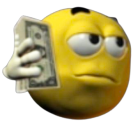way back in ye olde when i was studying mandarin in high school my teacher showed me this animation and it's stuck with me ever since. this piece, titled "the three monks", is an orchestrated silent cartoon depicting the interaction of three buddhist monks meeting at a temple on top of a tall hill. it's a very simple story of material pettiness getting the better of those that should know better, only for a calamity in the end to clear their selfish minds and ultimately remind them that they are united in intent and purpose in visiting this hilltop shrine
though the story may be simple, this work is incredibly important in the context of contemporary chinese history. for over a decade, the communist dictator mao zedong instigated a brutal inquisition colloquially called the "cultural revolution", in which he attempted in vain to destroy all traditional culture and religion in china to hurry the promised "end of history" proposed by the scientific marxists of his time. temples were destroyed, monks were slaughtered, and many ancient texts were burned by the young academics and government officials that mao's radical sentiments swept up. after his death in 1977, china internally reeled and wrestled with the brutal policies of the dictator and the seemingly irreversible damage inflicted on their culture by the maoist regime, and there was no unified consensus on what to do next after this one man's radical ferver died with him
in the following years after tradition was no longer put to the sword, many artists, poets, and artisans set out to try and reinvigorate the latent chinese spirit suppressed by the bloody revolution, and yet again along with all the other oppressed peoples of the world they proved through their work that such timeless ideals may not be so readily destroyed by even those most bent on erasing them. this work was the first animation produced after the end of the cultural revolution, and its bright colors and fluid motion combined with a fantastic orchestration of traditional instruments and a simple, timeless moral was a beacon, one of many indicators that the chinese spirit had endured mao's terrible reign
i still love this animation many years later and i still listen to the music on its own because of its magnificent beauty. i am very much pleased with those sorts of creative works in which there is no spoken or written dialogue, as everything else must be so much more expressive to convey the meaning without the use of words. the style of the animation is very pleasant to me as well, very simple but not in a reductive way. everything that is necessary is there, no more and no less. it is often difficult for me to accept animation as a proper art form in the same way i revere other forms, but it is works like this that truly make me reconsider that notion as i find this to be on par with even a masterful ballet or sacred oratorio. it is goode i liek it :D
"I know what I must do, be strong lest I shall perish!" 💪✡

I really enjoyed watching this piece.
Also think the Buddhistic values of Karma are shown nicely. While not karma in the sense of rebirth, their pettiness towards each other did result in their place almost burning down.
Im not sure of the function of the rat in Chinese culture, but at least for Japanese culture it is told to be a mischievous animal. A deceiver of sorts. Do you think the rat also function in that sort of way in this animation?
Also think the Buddhistic values of Karma are shown nicely. While not karma in the sense of rebirth, their pettiness towards each other did result in their place almost burning down.
Im not sure of the function of the rat in Chinese culture, but at least for Japanese culture it is told to be a mischievous animal. A deceiver of sorts. Do you think the rat also function in that sort of way in this animation?
hosimati suisei please

it definitely serves as a trickster in the animation and they do tend to be portrayed in such a way in the culture, but i do know that in the mythology surrounding the chinese zodiac it is said that the rat won his place in the heavens by his quick wit and cunning by tricking the other animals, and is therefore associated with a sort of sly intelligence in that way as well. it's not always negative, though
coincidentally i was born on the year of the rat so that's why i know a few things about it, and i've been called a rat before though in a very derogatory way so maybe the eastern astrologers are onto something
coincidentally i was born on the year of the rat so that's why i know a few things about it, and i've been called a rat before though in a very derogatory way so maybe the eastern astrologers are onto something
"I know what I must do, be strong lest I shall perish!" 💪✡
